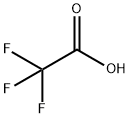Trifluoroacetic acid (TFA, molecular formula: CF3COOH) is a kind of colorless, volatile and fuming liquid with a similar odor as acetic acid. It is hygroscopic and has irritating odor. It has strong acidic property due to being affected by the electron-attracting trifluoromethyl group with its acidicity being 100000 higher than acetic acid. It has a melting point being-15.2 ℃, boiling point being 72.4 ℃, and the density being 1.5351g/cm3 (1℃). It is miscible with water, fluorinated hydrocarbons, methanol, ethanol, ethyl ether, acetone, benzene, carbon tetrachloride, and hexane; it is partially soluble in carbon disulfide and alkane containing more than six carbons. It is an excellent solvent of protein and polyester. It is also a good solvent for the organic reaction which allows obtaining certain results which are difficult in the cases of application of common solvents. For example, when quinolone is being catalyzed for hydrogenation in a common solvent, the pyridine ring is preferentially hydrogenated; in contrast, the benzene ring will be preferentially hydrogenated in the presence of trifluoroacetic acid as the solvent. Trifluoroacetic acid is decomposed into carbon dioxide and fluorine in the presence of aniline. It can be reduced by sodium borohydride or lithium aluminum hydride into trifluoroacetic acetaldehyde and trifluoro-ethanol. It is stable at temperature higher than 205 ℃ stable. But its ester and amides derivatives are easily subject to hydrolysis which allows them to prepare carbohydrate, amino acids, and peptide derivative in the form of acid or anhydride. It is easily to be dehydrated under action of phosphorus pentoxide and be converted to trifluoroacetic anhydride.
Trifluoroacetic acid is a kind of important intermediates of fat fluorine. Owing to the special structure of trifluoromethyl, it has a different property from other alcohols and can participate in a variety of organic reactions, especially being used in the field of the synthesis of fluorine-containing pharmaceutical, pesticides and dyes. Its domestic and foreign demand is increasing and has become one of the important intermediates for fluorine-containing fine chemicals.

